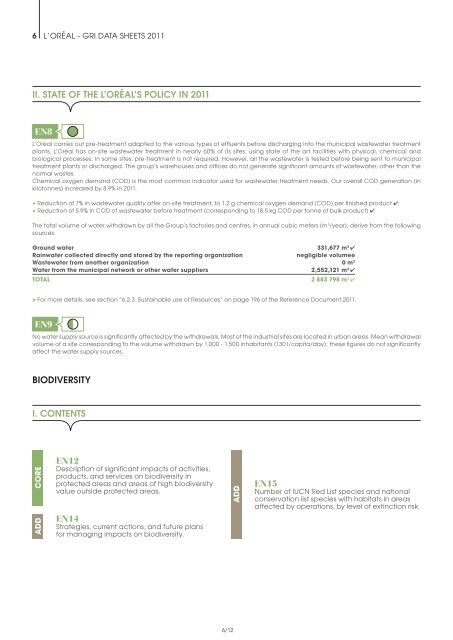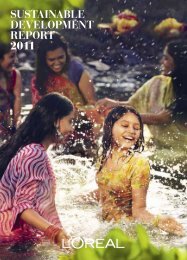Organizational Strategy - Sustainable Development - L'Oréal
Organizational Strategy - Sustainable Development - L'Oréal
Organizational Strategy - Sustainable Development - L'Oréal
Create successful ePaper yourself
Turn your PDF publications into a flip-book with our unique Google optimized e-Paper software.
6 L’oréaL - GrI DaTa SHEETS 2011<br />
II. STATE OF THE L’ORéAL’S POLICY IN 2011<br />
EN8<br />
L’oréal carries out pre-treatment adapted to the various types of effluents before discharging into the municipal wastewater treatment<br />
plants. L’oréal has on-site wastewater treatment in nearly 60% of its sites, using state of the art facilities with physical, chemical and<br />
biological processes. In some sites, pre-treatment is not required. However, all the wastewater is tested before being sent to municipal<br />
treatment plants or discharged. The group’s warehouses and offices do not generate significant amounts of wastewater, other than the<br />
normal wastes.<br />
Chemical oxygen demand (CoD) is the most common indicator used for wastewater treatment needs. our overall CoD generation (in<br />
kilotonnes) increased by 8.9% in 2011.<br />
• reduction of 7% in wastewater quality after on-site treatment, to 1.2 g chemical oxygen demand (CoD) per finished product 4;<br />
• reduction of 5.9% in CoD of wastewater before treatment (corresponding to 18.5 kg CoD per tonne of bulk product) 4.<br />
The total volume of water withdrawn by all the Group’s factories and centres, in annual cubic meters (m 3 /year), derive from the following<br />
sources.<br />
Ground water 331,677 m3 4<br />
Rainwater collected directly and stored by the reporting organization negligible volumee<br />
Wastewater from another organization 0 m3 Water from the municipal network or other water suppliers 2,552,121 m3 4<br />
TOTAL 2 883 798 m3 4<br />
> For more details, see section “6.2.3. <strong>Sustainable</strong> use of resources” on page 196 of the reference Document 2011.<br />
EN9<br />
No water supply source is significantly affected by the withdrawals. Most of the industrial sites are located in urban areas. Mean withdrawal<br />
volume of a site corresponding to the volume withdrawn by 1,000 - 1,500 inhabitants (130 l/capita/day): these figures do not significantly<br />
affect the water supply sources.<br />
BIOdIvERSITY<br />
I. CONTENTS<br />
CORE<br />
ADD<br />
EN12<br />
Description of significant impacts of activities,<br />
products, and services on biodiversity in<br />
protected areas and areas of high biodiversity<br />
value outside protected areas.<br />
EN14<br />
Strategies, current actions, and future plans<br />
for managing impacts on biodiversity.<br />
6/12<br />
ADD<br />
EN15<br />
Number of IUCN red List species and national<br />
conservation list species with habitats in areas<br />
affected by operations, by level of extinction risk.






